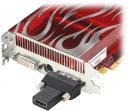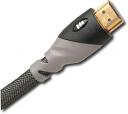Why HDMI is unsuitable for PCs, and about DisplayPort
In my last news roundup, I casually noted that “HDMI is not suited for PC connections”. I’ve since received a few emails asking me to clarify this statement, so that’s what I’ll do here today. And also talk about the new DisplayPort connector.
There are actually a few reasons why I said HDMI was not suitable for PCs. HDMI is pretty much now accepted as *the* digital home theatre connection of choice shows that HDMI is here to stay, but that’s not really the case with PCs – HDMI is still pretty rare on PCs. Whether this proves HDMI is unsuitable for PCs or not, that’s debatable, but what it does show is that HDMI uptake on PCs is still very slow. And there are probably good reasons for it.
First the foremost, most monitors on the market do not support HDMI connectors. And because HDMI is backwards compatible with DVI-D and that HDMI can carry digital/analog audio, it means that adding a HDMI connector to a monitor that doesn’t have speakers (which is the majority of them) is a bit of an overkill. Especially when said monitor will almost always have a DVI port anyway.
And even when the monitor has speakers, the way the PC is organized into separate components means audio through HDMI is always a bit tricky. Normally, the graphics card should have the HDMI connector, but should it also handle sound processing. Or should that be the sound card? But a sound card having HDMI is even weirder – what about the video signal then? Basically PC users are used to the idea of video and audio being separate cards and connections, and with HDMI, this sort of breaks down a bit. Still, it won’t stop companies like ATi providing audio through HDMI ports on their graphics cards, even if it is a bit weird.
Moving away from the PC to the other end – if you are trying to connect your PC to a plasma or LCD screen through HDMI, you may often find that the screen does not support standard PC resolutions through the HDMI port. Usually, only 576/720/1080 i/p are supported. There might even be a separate DVI or VGA port on the screen that does support the usual PC resolutions like 1280×768. Windows will happily run at these non PC resolutions, provided you have the correct drivers. However, certain applications like games don’t like these non standard resolutions, and so if you are using your HTPC for more than just photos, music and movies, you may need to think twice about using HDMI through such a limited port. But there are screens that do support PC resolutions through HDMI, by utilising the backwards DVI compatibility. So basically not all HDMI ports are equal, and it can be quite confusing.
 And yes, there are many DVI to HDMI solutions and they work reasonably well (I’m using one, for example). However, because legacy DVI connectors may not have HDCP copy protection, just because you can use adapters or cables to plug everything in, it doesn’t mean it will all work. And then there is the issue of the RGB color space, and how certain DVI to HDMI setups require the screen to support the full RGB color space. If set incorrectly, you may get white/black crushes, and that’s if you’re lucky enough to have devices that allow you to change the color space in the first place.
And yes, there are many DVI to HDMI solutions and they work reasonably well (I’m using one, for example). However, because legacy DVI connectors may not have HDCP copy protection, just because you can use adapters or cables to plug everything in, it doesn’t mean it will all work. And then there is the issue of the RGB color space, and how certain DVI to HDMI setups require the screen to support the full RGB color space. If set incorrectly, you may get white/black crushes, and that’s if you’re lucky enough to have devices that allow you to change the color space in the first place.
To sum up, HDMI is perfect for the home theatre, but it seems a bit tacked on for PCs and not something that was thought out carefully as a replacement for DVI. DVI is getting old. Dual-link DVI is at best a temporary solution to the ever growing problem of increasing resolutions and bandwidth requirements. And as mentioned in the first part of this article, HDMI seems more at home in the home theater than in the office. So something to replace DVI, has the advantages of HDMI, and is designed for PCs primarily … I think this is where DisplayPort comes into the picture.
To be honest, I don’t want a new connector format, especially when it features yet another set of copy protection (this time, it’s DPCP – using 128-bit AES encryption). But it will at least be license and royalty free, and will support resolutions up to 2560×1600 with only a single cable, and that can only be a good thing. And because it is designed first and foremost for PCs, seeing a DisplayPort on a display device means it will definitely support PC resolutions, and that should sort out the confusion. And with DisplayPort being backwards compatible with DVI, HDMI and even the humble VGA connector, it all should connect without problem given a few dongles and adapters. This might free up HDMI to be come an audio-only connector for PCs (DP to TV, HDMI to receiver, for example), allowing sound card/chip manufacturers to provide the best high-bitrate audio support on PCs, without having to worry about how to handle the video part.
Or DP could have the effect of causing more confusion by adding a third (actually, fourth) connector type for PCs. Time will tell …



May 23rd, 2008 at 10:09 pm
[…] want to spend a bit more, then try and find a 24″ with 1080p support, perhaps with HDMI and DisplayPortinput as well. I can’t really justify the extra money over only 2 more diagonal inches, and as […]
June 8th, 2008 at 11:15 pm
[…] of time before HDMI sound cards became available, although since HDMI is also used for video, there is some confusion as to who should be making these cards: the graphics card companies, or the audio card companies. I think you will see similar offerings […]